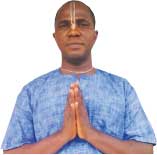Since there is a wide range of imaginations and perceptions about Yoga, we would like to give you a brief analysis about the original meaning of yoga and a description of different systems of yoga.
The word yoga is based on “yuj” (the root of the word) and means “to link with” or “to unite”. What is to be linked or united? The atma and the Paramatma – the soul and the Supreme soul or Supersoul. This definition is well known and generally accepted but there is one major misconception about it: many inexperienced yogis and jnanis think that “unite with” is to be equated with “to merge with”. Uniting, however, does not mean that the soul loses its individuality, but it means that the soul acts in accordance with the Supersoul. Each soul is the servant of the Supersoul-Krishna (God).
There are different yoga systems which can help us to reach this goal. The reason for the difference between the systems is that they are meant for particular ages and persons. Nevertheless they all have one goal in common: to become free from material bondage and to spiritualize the consciousness. People who are unfamiliar with the Vedic tradition of yoga see it as an exercise program or a way to relieve stress. Yoga does help in this way, but its main purpose is to help one regain their spiritual concsiousness and link again with God.
The following are the most prominent yoga systems: Raja-yoga or Astanga-yoga Raja means “royal” and astanga means “eightfold”. So the terms refer to the royal or eightfold path of liberation. This process reveals how one can reach liberation by gradually going through eight steps: yama: sense control niyama: rules and regulations asana: sitting postures pranavama: breathing exercises prarvahara: withdrawal of the senses from the sense objects dharana: concentration dhvana: meditation samadhi: self realization, spiritual trance
The following eight mystic perfections can be achieved by the practice of yoga: anima: to become smaller than the smallest mahima: to become bigger than the biggest laghima: to become lighter than the lightest prapti: to fulfil desires prakamya: to be able to experience any enjoyable object isita: to control sub-powers of maya vasita: to control others, avoid the influence of the 3 modes kamavasita: to get object s from anywhere The problem with mystic powers in general is that the practitioner cannot stop using them and thus falls into a subtle trap of maya by which he uses up his good karma and then no longer can control the senses.
Hatha-yoga Hatha yoga is not a yoga system in itself-as most people think-but one of the eight steps of the astanga yoga process. It includes specific sitting and breathing techniques by which one controls the life airs (prana, apana, vyana, samana and udana). The process is mainly meant to keep the body free from disease and the mind peaceful and stable. Mantra-yoga This is a simple system for spiritual advancement and is especially recommended in Kali Yuga for elevating one’s consciousness. Most people cannot sit and meditate for thousands of years as many yogis did in previous ages. There are mantras for material and spiritual goals.
Karma-yoga This is a process by which one can attain perfection through action. It is meant for those who are attached to fruitive, materialistic activities. Generally, the karma -yogi is interested in his own happiness, but is at the same time strictly following prescribed religious duties and offers the results of his activities as far as possible to God. Thus, karma -yoga is considered an intermediate state between material and spiritual life.
Jnana-yoga Through studies in the path of enlightenment, empirical studies and mental speculation debates, etc, the jnana-yogi tries to come closer to the Absolute Truth. Without proper guidance, however, it is very likely that one becomes bewildered or agnostic by following this path. Knowledge alone may show one the right direction but is not necessarily purifying the consciousness because even though someone may know something, it does not mean they will also have the realization.
Kundalini-yoga This process is in certain ways similar to Astanga-yoga. In addition, the yogi tries to awaken the kundalini shakti which is situated within the chakra of the lower back (muladhara chakra). Through specific techniques the kundalini is elevated through the sushumna channel to the highest cakra (sahas-rara). At this point the two shaktis are combined and at this time the successful yogi leaves together with the life air through the top of the head. An experienced guru is required since there is the danger of psychological and physical damages resulting from the practitioners’ inability to control the kundalini shakti after rising her up from the base.
BHAKTI-YOGA This process teaches one how to attain the Supreme through loving devotional service. In this way the goal of ALL the other yoga processes is easily achieved. Although it is the most direct and straight forward process to achieve the Supreme, it is the only one where the practitioner can be married.
Having a Krsna conscious child is bhakti-yoga. All other processes strictly demand complete celibacy, are comparatively mechanical and offer only artificial sense control. One example is of Visvamitra Muni – he was mediatiting and became agitated by the ankle bells of the heavenly society girl, Menaka. He was no longer able to control his senses and fell down with her. By chanting the Holy Names of the Lord, one is engaging in bhakti yoga and is able to achieve all perfection.
Hari das Thakur, one of Lord Caitanya’s intimate associates chanted 300,000 names of the Lord a day. He was approached by a prostitute who was Maya incarnate but he did not succumb to her advances and advised her to chant. The power of the Holy Name was that she gave up prostitution, accepted Hari das as her spiritual master, and chanted 300,000 names of the Lord a day for the rest of her life. There are two stages of Bhakti-yoga.
Vaidhi bhakti is the beginning stage where rules and regulations help the devotee get rid of their material attachments and begin practicing devotional service. Raganuga bhakti is the spontaneous unalloyed level of devotional service.
Only pure devotees are in this stage and one must not imitate them. Engage in Bhakti-Yoga, loving devotional service to Krsna and chant His Holy Names: Hare Krishna Hare Krishna Krishna Krishna Hare Hare Hare Rama Hare Rama Rama Rama Hare Hare

- Advertisement -
- Advertisement -
Must Read
Otti condoles with Nuhu Ribadu over brother’s death
Otti prayed that God would by His infinite grace comfort Ribadu and all the other family members.
By Jeffrey...












